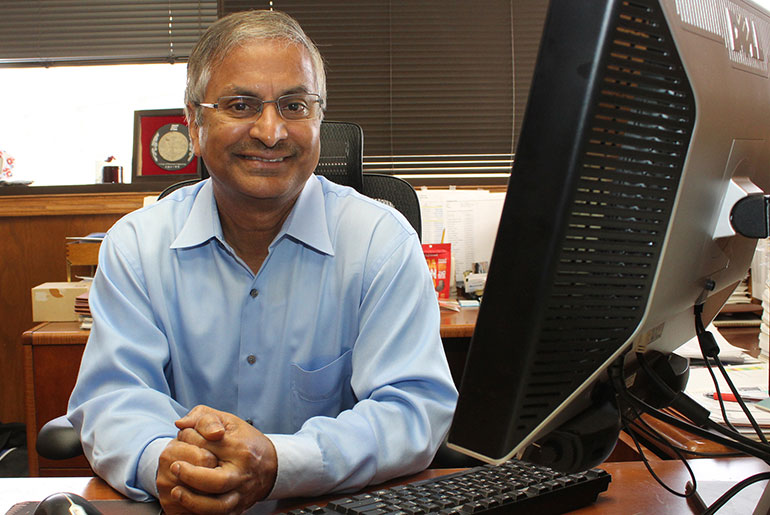
The practice of separating carbon dioxide (CO2) from power plant emissions goes back more than 30 years, when concerns were raised about its effects on the atmosphere. Sequestering CO2 usually means capturing it during power plant processes and concentrating it in a compressed state so it can be injected in a geologic storage reservoir deep underground. A discovery in 1972 determined that compressed CO2 gas could enhance oil recovery when it was injected in a hydrocarbon reservoir. Using CO2 to produce more oil and gas would seem to be a win-win situation today – good for the environment and good for energy production – but underground reservoirs have fractures and faults, meaning CO2 can potentially escape. To date, CO2 monitoring is mostly limited to surface measuring near injection sites and rarely tracks its movement underground.
Dr. Akhil Datta-Gupta, a University Distinguished Professor in the Harold Vance Department of Petroleum Engineering, is working to broaden those monitoring capabilities. He is the principal investigator on a Texas A&M Engineering Experiment Station (TEES) research project to develop a better method to track CO2 storage and use in oil production. His method has the potential to be far more rapid, practical and cost-effective than current efforts, meaning it would be a true win for energy and the environment.
“The oil is trapped because of something called interfacial tension, forces that hold the oil in small pores,” said Datta-Gupta. “The CO2 is miscible with the oil so we can actually drive the oil out of the smallest pores. Of course, one of the big challenges is how to track that CO2. Because if you are injecting the CO2 and it leaks back to the surface, then you are not getting any environmental benefit. You want to make sure that CO2 stays in the ground.”
Datta-Gupta’s process involves the accurate modeling of the hydrocarbon reservoir where the CO2 is going and the effects the CO2 has on pressure, temperature and subsurface formations in that area. He will be using the advanced imaging technology he developed for hydrocarbon reservoir investigation and management. This Fast Marching Method-based program is an efficient way of tracking the CO2 movement underground because it rapidly transforms the 3D governing equation of subsurface modeling into a one-dimensional equation, leading to orders of magnitude savings in computation over a full 3D simulation. This speed is needed for quick responses should the CO2 enter a fracture where it could potentially escape the reservoir.
“The focus here is real-time imaging of CO2 using temperature, pressure and time-lapse seismic data, or close to real-time imaging,” said Datta-Gupta. “So as the data is being generated and processed, we’ll use it to reconstruct the gas movement in the subsurface.”
Pressure and temperature data for the project will come from the injection site and monitoring wells at the Petra Nova carbon capture and storage site near Houston, Texas. The location is part of a joint venture between NRG Energy, JX Nippon Oil and Gas Exploration Corporation and Hilcorp Energy Company.
“For seismic monitoring, we basically send out sound waves and then we look at the properties of the reflected waves and reconstruct the image, similar to medical ultrasound imaging,” said Datta-Gupta.
Imaging the human body with its known properties is relatively routine but understanding unseen and unknown subsurface compositions will be difficult.
“We are not only trying to image the gas plume, we are at the same time trying to estimate what the properties of the medium are going to be,” said Datta-Gupta. “That’s what makes it doubly challenging for us.”
Datta-Gupta’s research project is titled “Robust Carbon Dioxide Imaging Using Joint Tomographic Inversion of Seismic Onset Time and Distributed Pressure and Temperature Measurements” and it is funded by the Department of Energy’s Safe and Permanent Storage Program with a $1.2 million budget aimed at mitigating greenhouse gases. The project team includes Battelle Memorial Institute as a subcontractor. Further support is provided by Shell Global, Anadarko Petroleum Corporation, Chevron Corporation, and JX Nippon Oil and Gas Exploration Corporation to an estimated amount of $300,000.
While the generous funding makes the project one of the top grant awards for TEES this fiscal year and garnered an Engineering Genesis Award for Multidisciplinary Research for Datta-Gupta, his focus is on the challenges and developments the research presents.
“This is very exciting, to be getting data from the largest CO2 sequestration project in the world,” said Datta-Gupta. “It opens up a lot of research opportunities for us as a department to dive into new areas, which is carbon capture, utilization, and sequestration; this is going to become increasingly important in the future.”
